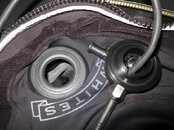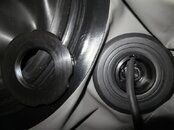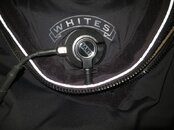If anyone installed a heater inflator valve, I'd be grateful if you could share your experiences. I'm installing Santi Thermovalve in my Whites Fusion.
I've already extracted the Apeks valve. The outer cap of the Thermovalve seems to fit the suit: there is a groove on the valve that matches one of the grooves on the outer rubber patch, as shown below. The inner part seems a bit more problematic. The suit has a bunch of grooves on the inside rubber patch as well, and the apeks Valve has matching grooves, but the inner portion of the Santi valve has a completely flat sealing surface. I wonder if it's a good idea to put something between the valve and the suit. Reusing the inner cap from the Apeks valve is not an option I'm considering yet, since I couldn't thread the cord through it without drilling holes in it.


Installation is also a bit problematic... since the inner cap has a flat sealing surface, the valve grabs the suit stronger on the inside than on the outside, so the only way I can tighten it is by rotating the outside. I guess not a big deal, just seems odd, so I wonder if I'm missing something obvious...
The other issue is the positioning of all the outlets. I intend to use this setup in backmount and sidemount, with drysuit inflator coming from different sides (from under the left armpit in backmount, and from the right tank in sidemount). The only sensible positioning that comes to mind is one with the E/O outlet pointing horizontally straight to the right, and leaving the inflator 90-degree range from point horizontal, to going straight down. Not optimal, though...

What does your setup look like? Any thoughts you can offer?
I've already extracted the Apeks valve. The outer cap of the Thermovalve seems to fit the suit: there is a groove on the valve that matches one of the grooves on the outer rubber patch, as shown below. The inner part seems a bit more problematic. The suit has a bunch of grooves on the inside rubber patch as well, and the apeks Valve has matching grooves, but the inner portion of the Santi valve has a completely flat sealing surface. I wonder if it's a good idea to put something between the valve and the suit. Reusing the inner cap from the Apeks valve is not an option I'm considering yet, since I couldn't thread the cord through it without drilling holes in it.


Installation is also a bit problematic... since the inner cap has a flat sealing surface, the valve grabs the suit stronger on the inside than on the outside, so the only way I can tighten it is by rotating the outside. I guess not a big deal, just seems odd, so I wonder if I'm missing something obvious...
The other issue is the positioning of all the outlets. I intend to use this setup in backmount and sidemount, with drysuit inflator coming from different sides (from under the left armpit in backmount, and from the right tank in sidemount). The only sensible positioning that comes to mind is one with the E/O outlet pointing horizontally straight to the right, and leaving the inflator 90-degree range from point horizontal, to going straight down. Not optimal, though...

What does your setup look like? Any thoughts you can offer?
Last edited:




